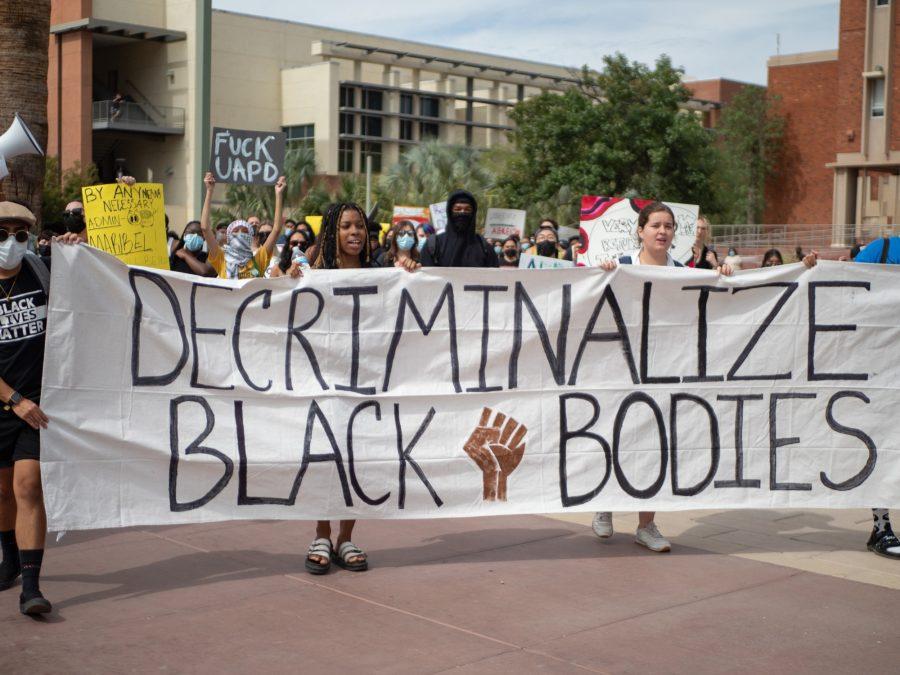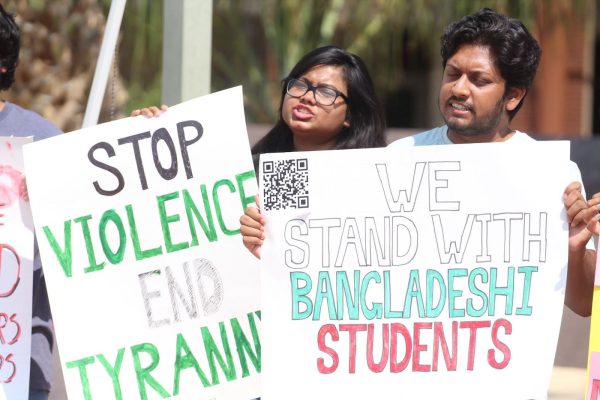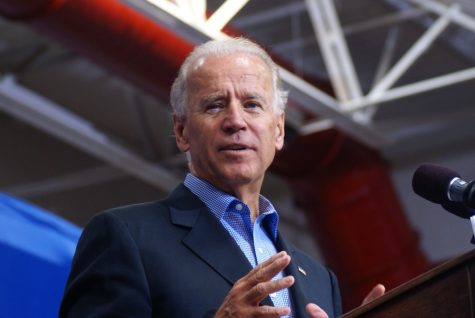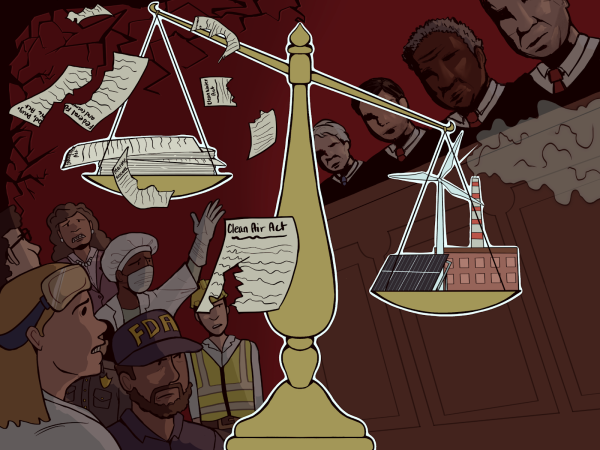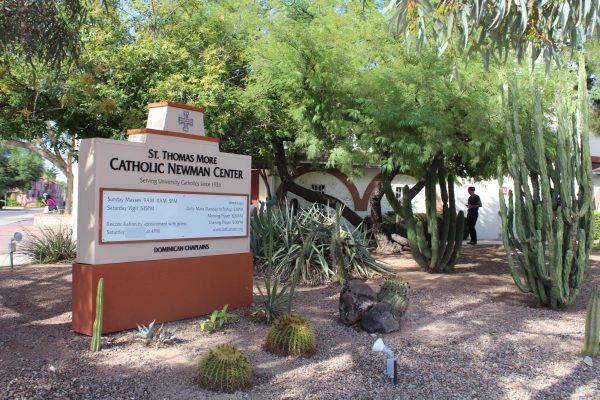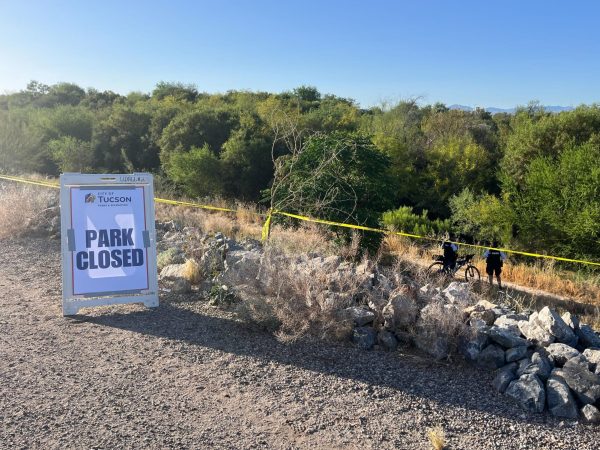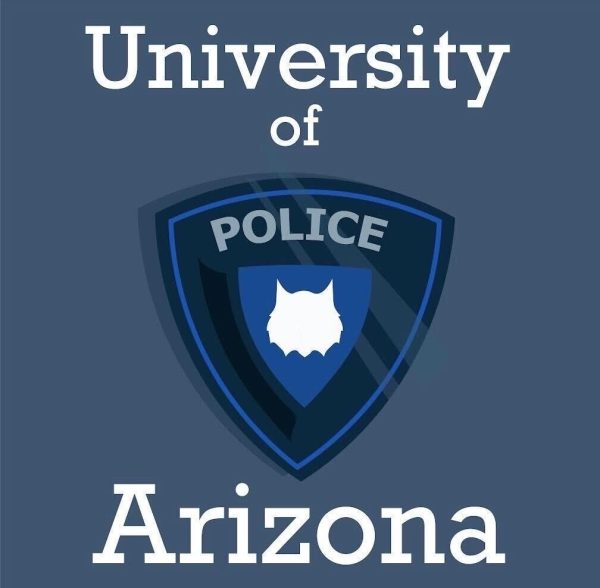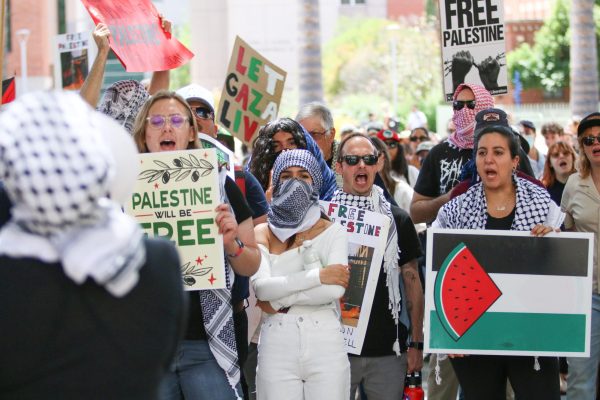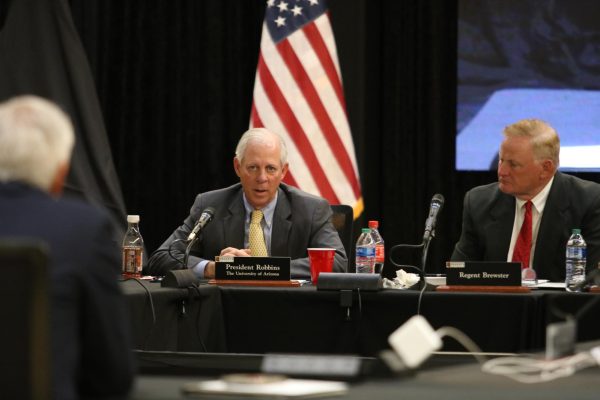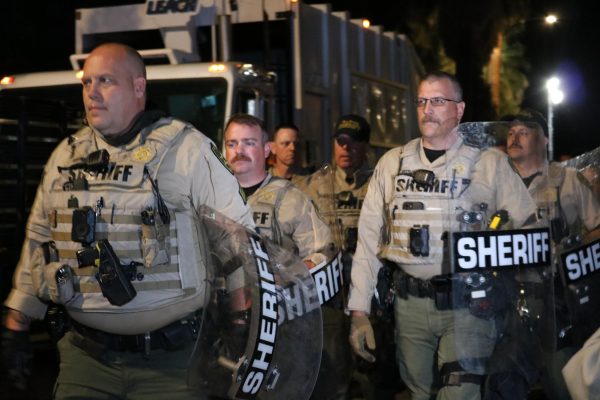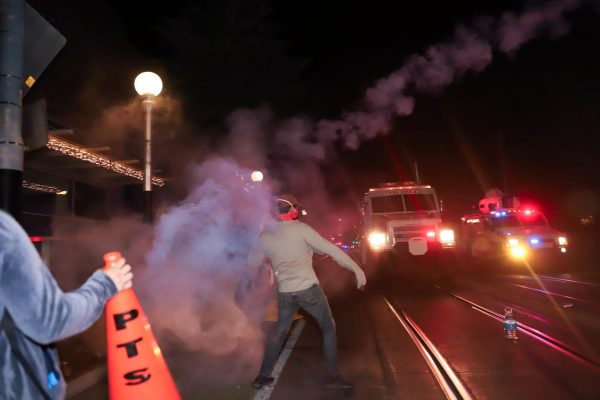Abuse of power and lack of accountability on the University of Arizona campus
The Coalition of Black students and Allies protested for the decriminalization of Black bodies. The protest took place on the University of Arizona campus on Friday, Oct. 14.
November 15, 2022
The Interim Associate Vice Provost of the University of Arizona’s Office of Diversity, Equity and Inclusion Maribel Alvarez, called the police on Kai Leigh Harriott, a Black, disabled queer student.
The incident took place on Sept. 30, at the Martin Luther King building. The MLK building is home to African American Student Affairs where many Black students often go.
Though the phone call took place on Sept. 30, the first negative encounter between Alvarez and Harriott was on Aug. 31, the day of the annual open house hosted by AASA.
The Aug. 31 incident: Harriott and Alvarez file respective reports
One of the accessible bathrooms in the MLK building is located on the third floor of the building near Alvarez’s office. Harriott said she went to the third floor and saw Alvarez upon arrival. They exchanged pleasantries and Alvarez asked Harriott how her summer was.
Over the summer, Harriott was assaulted and shared this information with Alvarez. Harriot told Alvarez that due to her unfortunate circumstances she wasn’t able to meet her academic obligations. Once Alvarez heard that her academic obligations were not met, Alvarez began to say that she did a lot for Harriott and Harriott should be thankful. During their conversation, there were office doors open.
“I kept reminding her that I’ve thanked her multiple times and I don’t feel that this is an appropriate conversation,” Harriott said. “I don’t really know what it is that I can say more than that. If I feel like a situation is inappropriate … I don’t have to be subjected to inappropriate conversations.”
When Harriott tried to leave and exit the situation, Alvarez proceeded to stand in the way of Harriott’s wheelchair and put her finger in Harriott’s face and further discredited Harriott’s experience, she explained.
“I defended myself by saying get out of my face. As a disabled woman, that’s as much as I can do for protection and hope that what I say is enough,” Harriott said.
The following day after their interaction, Harriott filed a report with the UA’s Office of Institutional Equity against Alvarez. Alvarez filed her own report against Harriott but with the University of Arizona Police Department.
Without being asked for any information about what took place, to speak with an investigator or even a confirmation email saying her report was received by OIE, Harriott received an email from OIE saying that her report would not be investigated by them at all.
“When I received the letter, it didn’t have my first name, my last name wasn’t spelled correctly, it didn’t have the proper arizona.edu email, it just looked like it wasn’t done properly,” Harriott said. “It’s hurtful because I took the time to share my experience, and they couldn’t even properly address me.”
Instead, she was told to talk to Human Resources, who informed her that they do not have the jurisdiction to investigate a complaint made by a student against a university employee. HR gave Harriott resources on what she could do next, including filing a report with OIE. Each of the resources offered to Harriott effectively just led her in a circle with nowhere to go with her report against an administrator, she explained.
“The university is not acknowledging the fact that there is a huge power imbalance here with my report not being taken seriously but [Alvarez’s] report being taken seriously. The playing fields are not level, so as an admin she’s able to do these things and be believed and make a report and be heard when I have not had that same experience,” Harriott said.
After the Aug. 31 incident and the respective reports that followed, there had not been any action taken by either party up to the day of Sept. 30. Alvarez declined to comment about her role in the incident that day when asked to interview.
The Sept. 30 incident: Harriott records the video and Alvarez calls UAPD
Harriott is the president of the UA Black Student Union. As president, she said it is commonplace for her to request a meeting with Alvarez or other admin in similar roles, with the intention to discuss Black students’ needs on campus and how they could work together.
Harriott and Georgina Andrade, a UA Diversity and Inclusion administrative associate, scheduled for BSU members to have a meeting with Alvarez on Sept. 30.
However, later that same day, Harriott said Andrade went to the AASA cultural center, where Harriott and other members of BSU were, and announced that Alvarez would no longer meet with them.
Curious to find out why, Harriott went to Alvarez’s office to question her about why she refused to meet with BSU. She said Alvarez claimed to have nothing to say to them when Harriott tried to explain that the intended meeting was not about what Alvarez had to say, but what BSU needed to say to her.
Alvarez then said she felt as though Harriott had been aggressive towards her on Aug. 31 and charged her wheelchair at her. Alvarez said she filed a police report describing Harriott as the aggressor. Harriott said the opposite was true of the Aug. 31 incident, because she said Alvarez actually blocked her from leaving the situation by standing in front of her wheelchair.
As Harriot tried to keep talking on Sept. 30, Alvarez got up from her desk to close her office door while Harriott was still in the doorway. The student said she was unable to move due to the hallway not being wheelchair accessible.
During this, Harriott took her phone out to record the situation to have proof of what was happening in Alvarez’s office. In the video, Alvarez continued to say Harriott was the aggressor, while Harriott told Alvarez she is a liar and ableist.
Former Director of AASA Brenda Anderson, who at the time of the incident was the director of AASA, and Coordinator of AASA Tehan Ketema, got to the third floor of the MLK building and attempted to de-escalate the situation. They were the only two staff members in the building to get involved, despite other offices on the third floor.
Eventually, Anderson, Harriott and Ketema returned to the AASA cultural center. This is where Harriott then told Anderson that Alvarez filed a police report against her and asked Anderson to help her leave the building. During this, Alvarez, while in communication with UA Dean of Students Kendal Washington White, called UAPD to the MLK building, according to the Sept. 30 police report.
Shortly after Alvarez’s initial call, three UAPD cars arrived at the MLK building and parked their cars at each of the accessible ramps to the building, in a move which the UA’s Coalition of Black Students and Allies said was, “weaponizing the ableist architecture that the university is entirely made out of.”
According to accounts heard by Harriott from students present at the time, UAPD came into the building and began questioning Anderson and other students in the space about Harriott’s whereabouts and actions. They asked questions like: “Was Harriott violent?” and “Was she making them uncomfortable?”
“I’m just really hurt and upset that my friends and people in the space were traumatized by [UAPD] and also worried about me as well,” Harriott said. “It was just a lot of high emotions, because no one really knew what was going on and to see multiple police officers with guns you would think something really happened.”
About 15 minutes after UAPD officers left the MLK building, Anderson received an email saying there would no longer be funding for her position. Shortly after, she was removed from her position as a whole.
According to a timeline of the whole situation, organized by COBA, this was despite the fact Anderson was told she would remain the interim director of AASA until June 30, 2023, in a meeting of UA campus cultural directors and coordinators just four days prior to the Sept. 30 incident.
Anderson’s firing immediately following the presence of UAPD at the center raised concerns from student staff of the center and students who frequent AASA as a whole.
The immediate reaction: COBA alerts the community, organizes a protest
The larger student population was made aware of the events Oct. 4. Social media posts on the Instagram pages of BSU and COBA explained in detail what took place on Sept. 30, drawing the interest of university community to what was happening within AASA and what Harriott called retaliatory efforts taken by those in administration.
Harriott said she views White’s involvement with Alvarez in this incident as concerning, because each of the original reporting avenues offered to Harriott by HR are overseen by White.
“She oversees student conduct, she oversees BEST, which was one of the options they gave me, she oversees the [Disability Resource Center], she oversees [Counseling and Psych Services] and then [Alvarez] oversees the Cultural Centers,” Harriott said. “So there’s a lot of power here between [White] and [Alvarez] and direct retaliation taken towards me.”
Harriott said White overseeing the systems that hold other administrators accountable is a conflict of interest. She said White made efforts to get Harriott barred from the MLK building and from campus as a whole.
Harriott shared that due to her speaking up and out about the events that happened to her, she is facing expulsion and had an injunction/order of protection filed against her by Alvarez, reporting Harriott for accounts of “stalking and threatening.” It is worth noting that this injunction filed was not given under oath.
According to the Sept. 30 UAPD police report obtained and posted online by COBA, White also falsely told Alvarez over text that Harriott was not a student at the UA, except she is.
According to the police report, when UAPD was at the space Anderson showed one of the responding officers that Harriott was in fact a student at the university and held multiple student jobs, further disproving White’s claim.
As the social media posts continued gaining traction with the student body and were shared widely, COBA planned a protest for Oct. 14.
“The goal of the protest was to let the community and students on campus know what was going on,” said Maryan Hassan, a student organizer within COBA. “It was in order to provide political education of how all of our shared struggles are connected. It was to show all these intersections of our identities and our backgrounds and find commonalities to be able to come together as a community and fight these struggles and demand more from the institution.”
After the protest, both BSU and COBA were still calling for action from the university about Alvarez and White’s actions. COBA published online their list of demands following the Sept. 30 incident.
The list of demands includes the immediate resignation of administrators such as Alvarez, White, Senior Business Manager for Diversity and Inclusion Alma Vejar and Director of Justice Initiatives Denise TrimbleSmith. They called for these resignations and a few others to be followed by a “national and competitive search to refill these student-centered positions.”
The list also included demands for an increase in scholarships and funds for Black students and for the entirety of the MLK building to be given back to AASA.
In calling for action to be taken by the university, COBA proceeded to post meme-like images featuring Alvarez and satirical text related to the situation at hand. This, along with other online criticism of Alvarez, caught the attention of the UA administration, including the school’s president, leading to an official address.
The UA’s response: President Robbins emails a conflicting statement
In a late night Nov. 1 email sent out to the school’s community, UA President Dr. Robert C. Robbins addressed the situation in an attempt to diffuse the situation and explain what the university was planning to do next, following the frequent criticism about the school’s lack of action from a mix of both students and faculty.
“It has been falsely shared that Dr. Maribel Alvarez, Interim Associate Vice Provost for Diversity and Inclusion, made the initial call to UAPD. She did not,” Robbins said in the email.
Further down the email, Robbins addressed the criticism of Alvarez.
“Despite the facts, Dr. Alvarez has been the subject of attacks on her character and threats, as have many other employees who serve our campus on issues related to equity, inclusion, diversity, student support and advancement, justice, and training. Let me be clear that the University will not tolerate harassment or threats against its employees or any member of our community,” Robbins said in the email.
Though COBA has made posts that do directly target Alvarez’s character, members say they have also worked to be transparent throughout this whole situation. So transparent that the following day after the email was sent, COBA publicly published the Sept. 30 UAPD police report to Instagram.
The police report gave more insight as to what took place and what conversations were held. The notes taken by UAPD also directly conflict with the statement made by Robbins in his email.
In the report, UAPD Officer Micholjon Amado said, “Upon arrival to the MLK Building, Officer Aguilar and I went to [redacted] and talked to Maribel Alvarez and she told me the following: A few minutes before she called UAPD at [3:18 p.m.], Alvarez walked … .”
Robbins said Alvarez never called UAPD, but COBA published the police report to prove she did do it.
“The top representative of the university is weaponizing his power to discredit the violence enacted toward black students,” COBA said in the post. “What will it take for us to be heard?”
Alvarez, White and Robbins, are all in high positions of power over students at the UA, particularly marginalized students on campus. COBA and BSU have said despite attempts to downplay the severity of the situation and to silence Harriott’s voice, they know the truth and are not afraid to share it.
Follow Kiara Adams on Twitter



